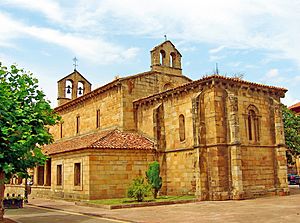Iglesia de Santa María de la Oliva (Villaviciosa) facts for kids
Quick facts for kids Iglesia de Santa María de la Oliva |
|
|---|---|
| Church of Santa María de la Oliva | |

Church of Santa María de la Oliva, in Villaviciosa.
|
|
| 43°28′55″N 5°26′13″W / 43.48193°N 5.43683°W | |
| Location | Villaviciosa, Principality of Asturias |
| Country | Spain |
| Denomination | Roman Catholic |
| Architecture | |
| Architectural type | Gothic church |
| Style | Spanish Gothic |
| Completed | 1270 |
The Church of Santa María de la Oliva is an old stone church located in Villaviciosa, a town in the Principality of Asturias, Spain. This beautiful church stands near the coast of the Biscay Bay in northern Spain. It is a special building because it shows a mix of two important historical building styles.
Contents
A Look at Its History
This church was built a very long time ago, between the late 1200s and early 1300s. To be more exact, it was completed around the year 1270. This period was a time of change in how buildings were designed. The Church of Santa María de la Oliva is considered one of the later churches built in the Romanesque style in the Villaviciosa area.
Its Unique Architectural Style
The Church of Santa María de la Oliva is known as a "transitional" church. This means it combines features from two different architectural styles: Romanesque and Gothic.
Romanesque Features
Romanesque architecture was popular in Europe from about the 10th to the 12th century. Buildings in this style often look very strong and solid. They usually have thick walls, round arches, and small windows.
Gothic Features
Gothic architecture came after Romanesque, starting in the mid-12th century. Gothic buildings are known for being much taller and having lots of light. They feature pointed arches, large stained-glass windows, and flying buttresses (supports on the outside).
A Mix of Styles
Because the Church of Santa María de la Oliva was built during a time when builders were moving from Romanesque to Gothic styles, it has elements of both. You can see the solid feel of Romanesque, but also some of the taller, more detailed parts that are typical of Gothic design. This makes the church a fascinating example of how architecture changed over time.
See also
 In Spanish: Iglesia de Santa María de la Oliva (Villaviciosa) para niños
In Spanish: Iglesia de Santa María de la Oliva (Villaviciosa) para niños
- Monasterio de Santa María de Valdediós
- Spanish Gothic architecture

